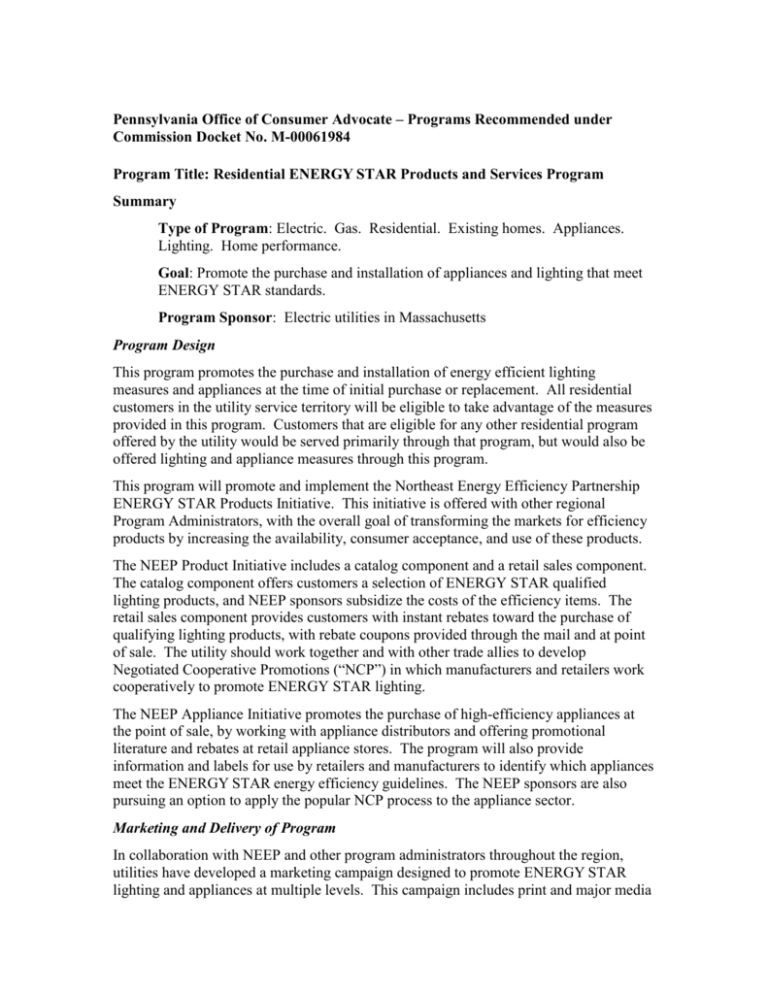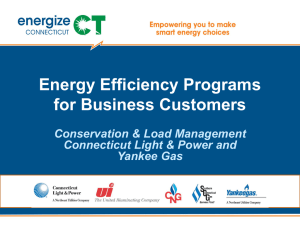Residential EStar Products & Services
advertisement

Pennsylvania Office of Consumer Advocate – Programs Recommended under Commission Docket No. M-00061984 Program Title: Residential ENERGY STAR Products and Services Program Summary Type of Program: Electric. Gas. Residential. Existing homes. Appliances. Lighting. Home performance. Goal: Promote the purchase and installation of appliances and lighting that meet ENERGY STAR standards. Program Sponsor: Electric utilities in Massachusetts Program Design This program promotes the purchase and installation of energy efficient lighting measures and appliances at the time of initial purchase or replacement. All residential customers in the utility service territory will be eligible to take advantage of the measures provided in this program. Customers that are eligible for any other residential program offered by the utility would be served primarily through that program, but would also be offered lighting and appliance measures through this program. This program will promote and implement the Northeast Energy Efficiency Partnership ENERGY STAR Products Initiative. This initiative is offered with other regional Program Administrators, with the overall goal of transforming the markets for efficiency products by increasing the availability, consumer acceptance, and use of these products. The NEEP Product Initiative includes a catalog component and a retail sales component. The catalog component offers customers a selection of ENERGY STAR qualified lighting products, and NEEP sponsors subsidize the costs of the efficiency items. The retail sales component provides customers with instant rebates toward the purchase of qualifying lighting products, with rebate coupons provided through the mail and at point of sale. The utility should work together and with other trade allies to develop Negotiated Cooperative Promotions (“NCP”) in which manufacturers and retailers work cooperatively to promote ENERGY STAR lighting. The NEEP Appliance Initiative promotes the purchase of high-efficiency appliances at the point of sale, by working with appliance distributors and offering promotional literature and rebates at retail appliance stores. The program will also provide information and labels for use by retailers and manufacturers to identify which appliances meet the ENERGY STAR energy efficiency guidelines. The NEEP sponsors are also pursuing an option to apply the popular NCP process to the appliance sector. Marketing and Delivery of Program In collaboration with NEEP and other program administrators throughout the region, utilities have developed a marketing campaign designed to promote ENERGY STAR lighting and appliances at multiple levels. This campaign includes print and major media designed to reach consumers, information and education provided to retail sales staff, as well as enlistment of partnerships and cooperative advertising with manufacturers and retail partners. The program is also promoted on the utilities’ web sites as well as the regional website, www.myenergystar.com. The tie-in to the ENERGY STAR brand also offers marketing and promotional opportunities through that national program. This program is delivered in coordination with other NEEP program administrators jointly utilizing three contractors. A retail outreach service coordinator provides recruitment, training, and placement of retail marketing materials. A marketing firm is used to develop and produce point of purchase advertisement as well as print and major media campaigns. A fulfillment contractor processes rebate applications and payments to customers and retailers. Addressing Households Using Electricity and Natural Gas The OCA urges the Commission to consider explicit integration of electric and gas measures. In may parts of the Commonwealth, consumers are customers of both gas and electric utilities. Many, significant savings opportunities will be missed if either the gas utility or the electric utility provide demand response, efficiency and education without treating the needs related to the other utility’s service. The OCA provides an abbreviated presentation of some gas-related proposals where these are essentially duplicated by our proposals related to electric programs. Efficiency Measures and Customer Incentives The lighting and appliance market tends to evolve relatively rapidly, with new appliance standards being set at the state and federal levels, and new efficiency products being offered on a regular basis. Accordingly, the specific appliances to be included in this program and the specific rebates to offer should be developed and updated by the sponsoring utility on an on-going basis. New standards should be applied as new products are introduced to the market, and rebates should be modified (and sometimes eliminated) to account for market developments. The lighting and appliance measures to be considered in this program include at least the following: Compact florescent bulbs. Exterior lighting fixtures. Interior lighting fixtures. Torchieres. Reflector lighting. Ceiling fans. Clothes washers. Room air conditioners. Dehumidifiers. Additional national ENERGY STAR and NEEP-coordinated initiatives may be offered during limited promotional times with regional partners (manufacturers and retailers). For example, the utility could support the EPA Change-A-Light, Change-the-World initiative, Cool Your World, and various Earth Day efficiency activities. Recent Program Performance: Lighting Only This program has been in operation since 1998. The performance results for the calendar year 2005 are summarized below. Program Budget ($/year) Massachusetts Electric NSTAR Electric Western Mass. Electric 6,268,264 4,335,926 935,886 Benefit-Cost Ratio 5.2 4.8 3.5 Net Benefits (million present value $) 39.3 22.9 2.9 Cost of Saved Electricity ($/lifetime MWh) 8.7 10.2 14.3 Recent Program Performance: Appliances This program has been in operation since 1998. The performance results for the calendar year 2005 are summarized below. Massachusetts Electric NSTAR Electric Western Mass. Electric 2,070,096 1,851,005 397,554 Benefit-Cost Ratio 4.3 2.9 2.1 Net Benefits (million present value $) 12.3 7.9 0.5 Cost of Saved Electricity ($/lifetime MWh) 37.9 35.7 66.8 Program Budget ($/year)







